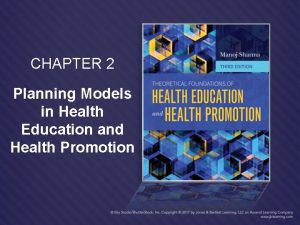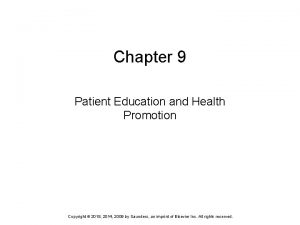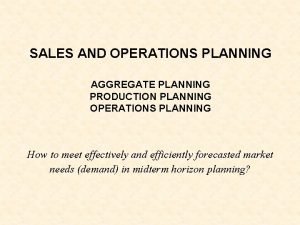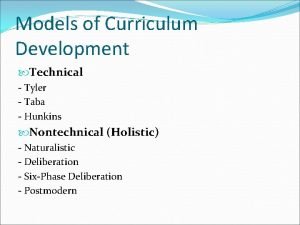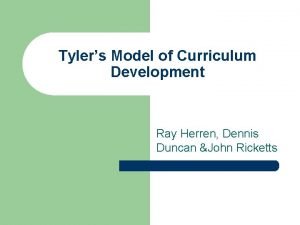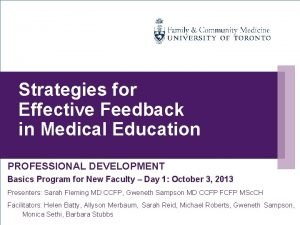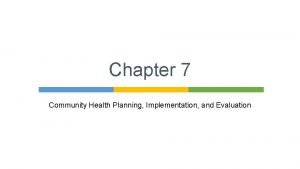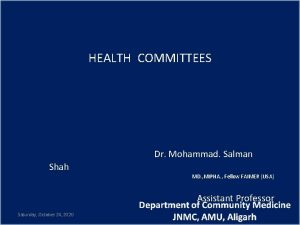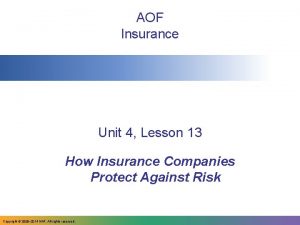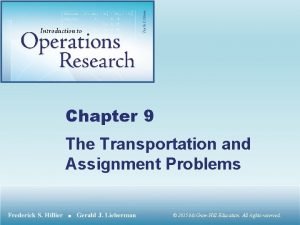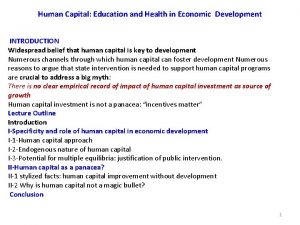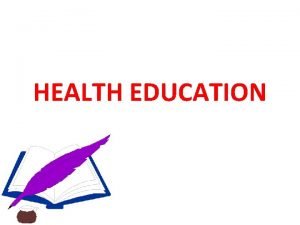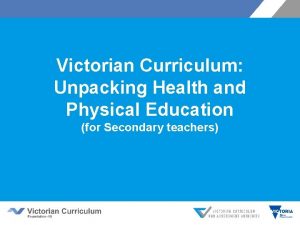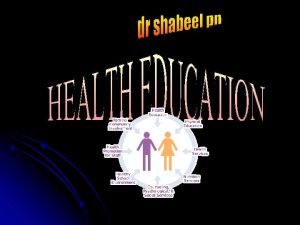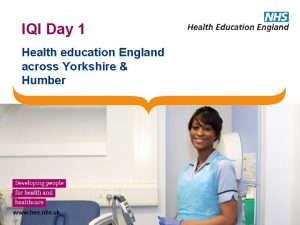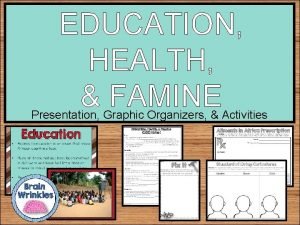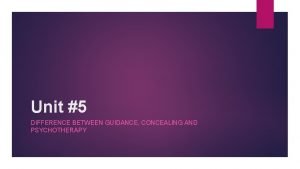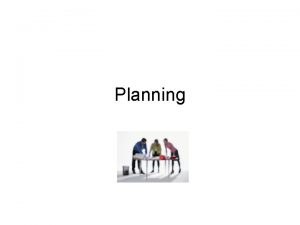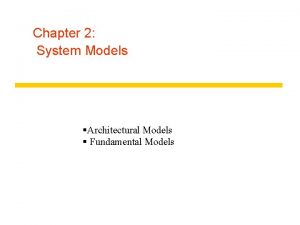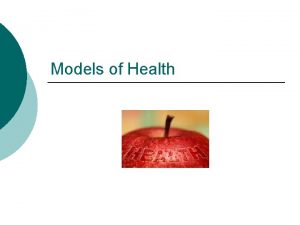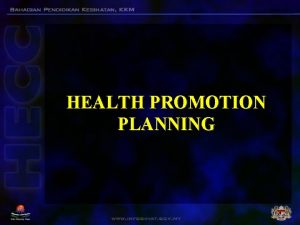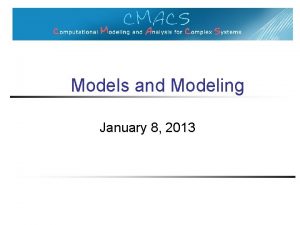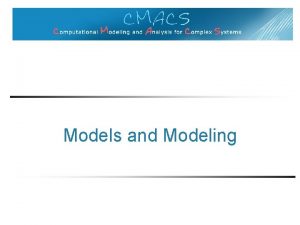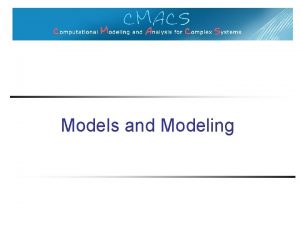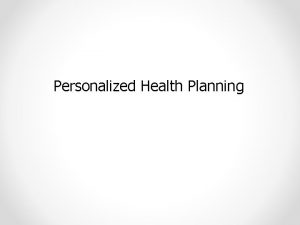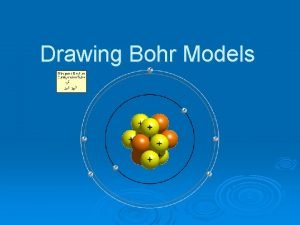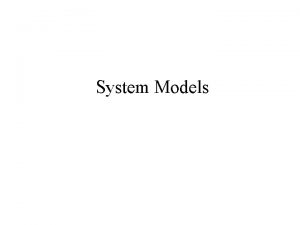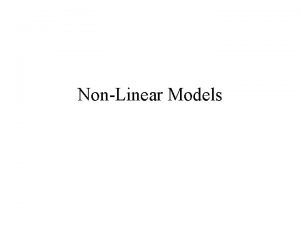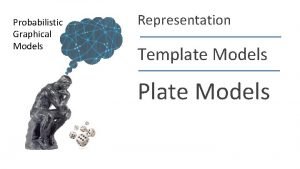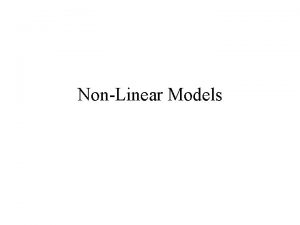CHAPTER 2 Planning Models in Health Education and









































- Slides: 41

CHAPTER 2 Planning Models in Health Education and Health Promotion

Concept of Model © Casper 1774 Studio/Shutterstock • Eclectic, creative, simplified, miniaturized applications of concepts toward addressing problems • Used for macro-level planning of interventions • May not have enough empirical evidence to be called a theory • Do not present guidance for micro-level management • Examples of models used in health education and health promotion: PRECEDE-PROCEED, MATCH, PATCH, Ecological Planning Approach

© GGuy/Shutterstock Concept of Theory • Set of interrelated concepts, definitions, and propositions that present a systematic view of events or situations by specifying relations among variables in order to explain and predict the events or situations • Refined through rigorous empirical testing

Competencies for Planning Health Education (HESPA, 2015) © Ivelin Radkov/Shutterstock 2. 1 2. 2 2. 3 2. 4 2. 5 Involve priority populations, partners, and other stakeholders in the planning process Develop goals and objectives Select or design strategies/interventions Develop a plan for delivery of health education/promotion Assess factors that influence implementation of health education/promotion

Definitions of PRECEDE-PROCEED • PRECEDE: Predisposing, reinforcing, enabling constructs in educational/ ecological diagnosis and evaluation • PROCEED: Policy, regulatory, and organizational constructs in educational and environmental development • EMPOWER: Expert methods for planning and organization within everyone’s reach

Applications of PRECEDE-PROCEED • • • Coalition building Enhancing community participation Planning health education programs Planning multiple-channel interventions Implementing health risk appraisals at worksites Planning Employee Assistance Programs (EAP) at worksites • Influencing healthy worksite culture • Comprehensive school health education • Improving self-care and compliance behaviors

Components of PRECEDE-PROCEED • Social assessment and situational analysis phase • Epidemiological assessment • Educational and ecological assessment • Administrative and policy assessment and intervention alignment phase • Implementation phase • Process evaluation • Impact evaluation • Outcome evaluation

Strengths of the PRECEDEPROCEED Model • Popular and most researched model • In existence for four decades • Very comprehensive and covers all areas of planning • Initiation of the model utilizes community inputs and participation • Phased evaluation is also a strong feature

Some Limitations of the PRECEDE-PROCEED Model • Too comprehensive to be applied in a reasonable time period at a setting • Requires heavy financial and human resource input to become functional • Mixture of several theories • Comparative studies lacking

Planned Approach to Community Health (PATCH) Model • Planning model developed in the mid 1980 s by the Centers for Disease Control and Prevention (CDC) in partnership with state and local health departments and several community groups • Capacity building is a very important part of the PATCH model

Key Elements of the PATCH Model • Community members participate in the process © Rawpixel. com/Shutterstock • Data guides the development of programs • Participants develop a comprehensive health promotion strategy • Evaluation emphasizes feedback and program improvement • Community capacity for health promotion is increased

Five Phases of PATCH Model 1. 2. 3. 4. Mobilizing the community Collecting and organizing data Choosing health priorities Developing a comprehensive intervention plan 5. Evaluation

CDC PATCH Model Communication Reproduced from: Centers for Disease Control & Prevention http: //wonder. cdc. gov/wonder/prevguid/p 0000064. asp

Other Planning Models • MATCH (Multilevel Approach to Community Health) – Phase 1: • Step 2: • Step 3: • Step 4: Goals Selection Select health status goal Select high-priority target population(s) Identify health behavior goals Identify environmental factor goals

Other Planning Models (cont’d) • MATCH (Multilevel Approach to Community Health) – Phase 2: • Step 1: • Step 2: • Step 3: • Step 4: Intervention Planning Identify the targets of the intervention Select intervention objectives Identify mediators of intervention objectives Select intervention approaches

Other Planning Models (cont’d) • MATCH (Multilevel Approach to Community Health) – Phase 3: • Step 1: • Step 2: • Step 3: • Step 4: Program Development Create program units or components Select or develop curricula and create guides Develop session plans Create or acquire instructional materials, products, and resources

Other Planning Models (cont’d) • MATCH (Multilevel Approach to Community Health) © dizain/Shutterstock – Phase 4: Implementation Preparations • Step 1: Facilitate adoption, implementation, and maintenance • Step 2: Select and train implementers

Other Planning Models (cont’d) • MATCH (Multilevel Approach to Community Health) Evaluation Conduct process evaluation Measure impact Monitor outcomes © safriibrahim/Shutterstock – Phase 5: • Step 1: • Step 2: • Step 3:

Other Planning Models (cont’d) • Intervention mapping – Needs assessment or problem analysis – Creating matrices of change objectives – Selecting theory-based intervention methods and practical strategies – Translating methods and strategies into an organized program – Planning for adoption, implementation, and sustainability of the program – Generating an evaluation plan

Other Planning Models (cont’d) • Assessment Protocol for Excellence in Public Health (APEXPH) – A form of self-assessment tool – Leads to development of a practical plan of action – Focuses on local health department’s capacity and the community’s actual and perceived needs

Other Planning Models (cont’d) • APEXPH (cont’d) – Helps a local health department build its relationship with other local governmental agencies, and community, state, and federal agencies – Provides a protocol through which a health department can assess health needs, set priorities, develop policy, and ensure that health needs are met – Fits local situations and resources

Other Planning Models (cont’d) • APEXPH (cont’d) © Shutterstock – Organizational capacity assessment – Community process – Completing the cycle

Other Planning Models (cont’d) • Sullivan (1973): Comprehensive Health Education Model (CHEM) – Involve people – Set goals – Define problems – Design plans – Conduct activities – Evaluate results

Other Planning Models (cont’d) • Ross and Mico (1980): Model for Health Education Planning (MHEP) – Initiate – Needs assessment – Goal setting – Planning/programming – Implementation – Evaluation

Other Planning Models (cont’d) • Model for Health Education Planning and Resource Development (MHEPRD) – Health education plans – Demonstration programs – Operational programs – Research programs – Implementation process – Information and statistics

Other Planning Models: PEN 3 Figure 2 -2: The PEN-3 model.

Other Planning Models (cont’d) • PEN-3 model – Cultural identity • P represents person • E represents extended family • N represents neighborhood

Other Planning Models (cont’d) • PEN-3 model (cont’d) – Relationships and expectations • P represents perceptions • E represents enablers • N represents nurturers

Other Planning Models (cont’d) • PEN-3 model (cont’d) – Cultural empowerment • P represents positive • E represents existential (exotic) • N represents negative

Other Planning Models (cont’d) • CDCYNERGY or Cynergy by CDC (1999) – Problem definition and description • Define the problem and consider resources – Problem analysis • Set goals

Other Planning Models (cont’d) • CDCYNERGY (cont’d) – Communication program planning • Choose primary and secondary target audiences and set communication objectives – Program and evaluation development – Program implementation and management – Feedback

Other Planning Models (cont’d) • Social Ecological models: – Based on the work of Urie Bronfenbrenner, a developmental psychologist – Five layers: • Microsystem: Immediate environment such as family, school, peer group, and worksite • Mesosystem: Linkages between two or more settings such as home and school

Other Planning Models (cont’d) – Five layers (cont’d) • Exosystem: Indirect influences, e. g. , for a child, the relationship between home and father’s workplace • Macrosystem: Culture comprising customs, lifestyles, belief systems, etc. • Chronosystem: Changes over time in the environment

Other Planning Models (cont’d) Figure 2 -3: Social-ecological model for planning multilevel health behavior interventions.

Application Exercise • Mkumbo and colleagues (2009) have used intervention mapping to develop and implement a school-based sexuality and HIV/AIDS education program in Tanzania. • The first step of this model entails performing needs assessment, which they conducted in a participatory manner, involving the researchers, the curriculum developers, the teachers, and the students. • The second step entails creating matrices of change objectives based on the determinants of behavioral and environmental conditions.

Application Exercise (cont’d) • The third and fourth steps entail choosing theory -based methods and developing a program. They developed a program consisting of five lessons, organized around 23 sessions, with the aim of delaying the onset of sexual intercourse and increasing correct and consistent condom use among young people. • The fifth step is about planning for the adoption, implementation and sustainability of the program, and the sixth step is about evaluation. The last two steps are not very clear in this application.

Application Exercise (cont’d) • This is an application of a Western model in a sub-Saharan African country. • Read this article and prepare a critique of 250 words.

Websites to Explore • Centers for Disease Control & Prevention (CDC) – http: //www. cdc. gov/ • Intervention mapping – http: //www. interventionmapping. com/ • National Association of County and City Health Officials (NACCHO) – http: //www. naccho. org/

Websites to Explore (Cont’d) • PRECEDE-PROCEED Model – http: //www. lgreen. net/precede. htm • Social-ecological model: Violence prevention – http: //www. cdc. gov/violenceprevention/overv iew/social-ecologicalmodel. html

Skill Building Activity • Choose any one behavior. • Choose any one target population where this behavior will be most suitable. • Draw a diagram explicating the links between various components of the PRECEDE-PROCEED model and the chosen health behavior. • Present your final work in a word-processed diagram.

Skill Building Activity (Cont’d) Figure 2 -4: Application of the PRECEDE-PROCEED model for changing moderate-intensity leisure time physical activity in a small group of African American women in a midwestern city through a brief first-time educational intervention.
 Public health planning models
Public health planning models Different between health education and health promotion
Different between health education and health promotion Difference between model and semi modal
Difference between model and semi modal Difference between counselling and health education
Difference between counselling and health education Patient readiness to learn
Patient readiness to learn Chapter 3 health wellness and health disparities
Chapter 3 health wellness and health disparities Glencoe health chapter 1 understanding health and wellness
Glencoe health chapter 1 understanding health and wellness Chapter 1 understanding your health and wellness
Chapter 1 understanding your health and wellness Supervision and appraisal
Supervision and appraisal Transportation matrix example
Transportation matrix example Advantage of curriculum
Advantage of curriculum Long term financial planning model
Long term financial planning model Models of curriculum planning
Models of curriculum planning Characteristics of effective feedback
Characteristics of effective feedback Proactive planning and reactive planning
Proactive planning and reactive planning Short medium and long term planning in education
Short medium and long term planning in education Language planning slideshare
Language planning slideshare Health and social component 3
Health and social component 3 Community health planning and implementation certificate
Community health planning and implementation certificate Mipha in medical
Mipha in medical Unit 2 lesson 3 health insurance and financial planning
Unit 2 lesson 3 health insurance and financial planning Unit 2 lesson 3 health insurance and financial planning
Unit 2 lesson 3 health insurance and financial planning Hungarian algorithm worksheet
Hungarian algorithm worksheet Chapter 1 graphs functions and models answers
Chapter 1 graphs functions and models answers How formal education differs from als
How formal education differs from als Hpe vic curriculum
Hpe vic curriculum Human capital education and health in economic development
Human capital education and health in economic development Aim of education
Aim of education Soil seed and sower in health education
Soil seed and sower in health education Victorian curriculum health and physical education
Victorian curriculum health and physical education Global consortium on climate and health education
Global consortium on climate and health education Soil seed and sower in health education
Soil seed and sower in health education Health education england yorkshire and humber
Health education england yorkshire and humber Define family life education
Define family life education Education health and famine comprehension check
Education health and famine comprehension check Difference between g u i n c e
Difference between g u i n c e Health education kent, surrey and sussex
Health education kent, surrey and sussex Sexual health and relationships education scotland
Sexual health and relationships education scotland Education health and famine cloze notes
Education health and famine cloze notes Strategic planning vs tactical planning
Strategic planning vs tactical planning Goal achievement matrix
Goal achievement matrix Role segmentation workforce planning
Role segmentation workforce planning
